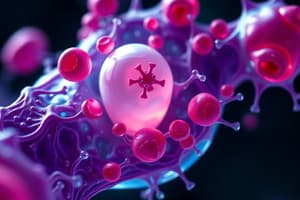Podcast
Questions and Answers
What is the function of Rough Endoplasmic Reticulum?
What is the function of Rough Endoplasmic Reticulum?
Protein synthesis for exocytosis, vacuoles, and lysosomes
What are the structural components of the Plasma Membrane?
What are the structural components of the Plasma Membrane?
Proteins, cholesterol, phospholipids, glycocalyx
Where are Mitochondria mainly found?
Where are Mitochondria mainly found?
Hepatocytes and cardiomyocytes
Match the following glands with their respective landmarks:
Match the following glands with their respective landmarks:
What are the structural proteins of Hemidesmosomes?
What are the structural proteins of Hemidesmosomes?
Where is Dense Regular Connective Tissue commonly found?
Where is Dense Regular Connective Tissue commonly found?
What are the characteristics of Cardiac Muscle?
What are the characteristics of Cardiac Muscle?
What cells secrete hormones in the Thyroid gland?
What cells secrete hormones in the Thyroid gland?
What hormones are secreted from the inner pigmented cells of Adrenal Gland?
What hormones are secreted from the inner pigmented cells of Adrenal Gland?
What type of collagen is found in Dense Regular Connective Tissue?
What type of collagen is found in Dense Regular Connective Tissue?
The Gastroesophageal Junction is also known as Rectoanal Junction.
The Gastroesophageal Junction is also known as Rectoanal Junction.
What is the main function of the Parathyroid gland?
What is the main function of the Parathyroid gland?
The cells responsible for bone formation and resorption are _______________ and osteoclasts.
The cells responsible for bone formation and resorption are _______________ and osteoclasts.
What is a characteristic of Skeletal Muscle?
What is a characteristic of Skeletal Muscle?
The Thyroid gland secretes hormones that regulate bone growth.
The Thyroid gland secretes hormones that regulate bone growth.
Match the following structures with their respective characteristics:
Match the following structures with their respective characteristics:
What are the two types of cells found in the Thyroid gland?
What are the two types of cells found in the Thyroid gland?
The Adrenal Gland secretes hormones such as _______________ and norepinephrine.
The Adrenal Gland secretes hormones such as _______________ and norepinephrine.
The Rectoanal Junction is a type of muscle.
The Rectoanal Junction is a type of muscle.
Flashcards are hidden until you start studying
Study Notes
Cell Organelles
- Rough Endoplasmic Reticulum (RER) synthesizes proteins for exocytosis, vacuoles, and lysosomes.
- Golgi Apparatus is involved in protein synthesis, concentration, and storage.
- Microvilli are involved in cytoskeleton protein synthesis, specifically Actin.
Cell Membrane
- Plasma Membrane is composed of proteins, cholesterol, phospholipids, and glycocalyx.
- Function: selective permeability.
Epithelial Tissue
- Pseudostratified columnar epithelium is found in the adrenal gland, zona fasciculata.
- Apical structure: Cilia.
- Structural protein: microtubules.
Organelles in Specific Cells
- Mitochondria are found mostly in hepatocytes and cardiomyocytes.
- Lysosomes are abundant in WBCs due to their phagocytic ability.
Cell Adhesion
- Desmosomes are involved in cell adhesion, with structural proteins clathrin and intermediate filaments.
- Locations: Spinosum cells (keratinocytes).
- Hemidesmosomes are involved in cell adhesion, with structural proteins integrin, keratin, and laminin.
Glands
- Identify the landmarks for the following glands:
- Thyroid gland: Colloid
- Posterior pituitary: Herrings Bodies
- Intermediate pituitary: Cysts derived from Rathke's pouch
- Pineal gland: Corpora Aracena
- Exocrine glands and their secretion types:
- Sebaceous Gland: Holocrine secretion
- Mammary Gland: Apocrine and merocrine secretion
Connective Tissue
- Hyaline Cartilage is a type of cartilage.
- Lamellar bone is a type of bone.
- Dense regular CT is found in tendons and ligaments, composed of type I collagen.
- Locations where the transition of epithelium takes place:
- Rectoanal Junction
- Gastroesophageal Junction (GEJ)
Muscle Tissue
- Cardiac Muscle: Involuntary, bi-nucleated, intercalated disks.
- Skeletal Muscle: Voluntary, striated, multinucleated.
- Bone: Cells: Osteoblasts, osteoclasts.
Endocrine System
- Thyroid: Cells that secrete hormones: Follicular and parafollicular cells.
- Parathyroid: Secretes ATH.
- Adrenal Gland: Hormones secreted from inner pigmented cells: Epinephrine, norepinephrine.
Cell Biology
- Rough Endoplasmic Reticulum (RER) functions in protein synthesis for exocytosis, vacuoles, and lysosomes.
- Golgi Apparatus synthesizes, concentrates, and stores proteins for microvilli.
- Plasma Membrane is composed of proteins, cholesterol, phospholipids, and glycocalyx, and provides selective permeability.
- Mitochondria are primarily found in hepatocytes and cardiomyocytes.
Epithelial Tissue
- Pseudostratified columnar epithelium has apical structures like cilia, and microtubules as structural proteins.
- Adrenal Gland (Zona Fasciculata) has smooth ER as the most abundant organelle.
Cell Adhesion
- Desmosomes have structural proteins like clathrin and intermediate filaments, and are found in spinosum cells (keratinocytes).
- Hemidesmosomes have structural proteins like integrin, keratin, and laminin.
Glands
- Sebaceous Gland secretes through holocrine secretion.
- Mammary Gland secretes through apocrine and merocrine secretion.
- Thyroid gland is identified by Colloid and has follicular and parafollicular cells that secrete hormones.
- Adrenal Gland secretes hormones like epinephrine and norepinephrine from inner pigmented cells.
- Parathyroid gland secretes ATH.
Connective Tissue
- Hyaline Cartilage is simple columnar epithelium with goblet cells.
- Dense Regular CT has type I collagen and is found in tendons and ligaments.
- Lamellar bone is a type of bone tissue.
- Elastic cartilage is a type of cartilage.
Muscles
- Cardiac Muscle is involuntary, binucleated, and has intercalated disks.
- Skeletal Muscle is voluntary, striated, and multinucleated.
Landmarks
- Herrings Bodies are landmarks for the posterior pituitary.
- Corpora Aracena is a landmark for the pineal gland.
- Rathke's pouch is a landmark for the intermediate pituitary.
Epithelial Transitions
- Epithelial transitions occur at the Rectoanal Junction and Gastroesophageal Junction (GEJ).
Studying That Suits You
Use AI to generate personalized quizzes and flashcards to suit your learning preferences.




